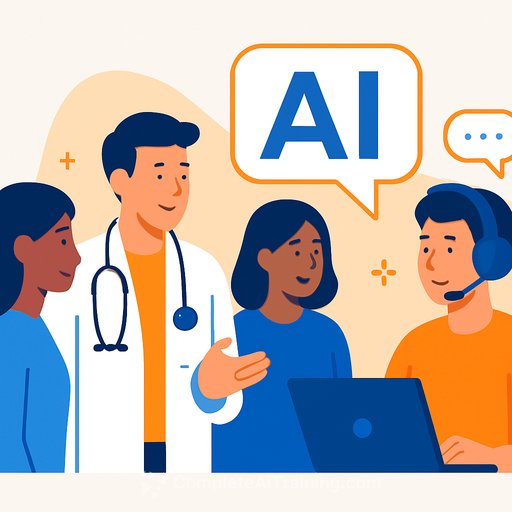AI interpreter app pilot at Affinia Healthcare: practical takeaways for language access at FQHCs
Affinia Healthcare, a community health center network in St. Louis serving large immigrant communities across six FQHC sites, ran a generative AI interpreter pilot in Q1 2025. Two leaders, Jennifer Winters, assistant vice president of value-based healthcare, and Dr. David Miller, clinical director of Affinia Convenience Care and assistant medical director, shared what worked, what didn't, and how they measured results.
If your team is weighing AI for interpretation, their experience offers a clear playbook: define the clinical boundaries, build strong fallback routes to human interpreters, and track outcomes that matter to patients and staff.
The challenge before the pilot
- High demand across many languages, including low-frequency dialects.
- Waits for phone/video interpreters during peak hours and after-hours gaps.
- Inconsistent use of qualified interpreters for brief or unplanned interactions (check-in, vitals, discharge questions).
- Rising costs per encounter for simple, short exchanges.
- Staff burden documenting interpreter use and managing handoffs.
What the team needed from an AI interpreter app
- On-demand access for common languages at the point of care.
- Clear escalation to certified interpreters for complex clinical conversations.
- Documented modality of interpretation in the EHR for compliance.
- Basic guardrails: medical terminology support, confidence cues, and an easy "switch to human" option.
- Privacy and security controls aligned with HIPAA and vendor BAAs.
How the Q1 2025 pilot ran
- Scope: front desk, triage, vitals, immunizations, pharmacy questions and routine follow-ups; complex visits excluded.
- Sites: multiple Affinia locations to reflect real demand across high-volume languages.
- Training: short role-based sessions for MA, nursing, and front-desk staff; quick-reference cards at workstations.
- Fallbacks: immediate handoff paths to qualified live interpreters when needed.
- Measurement: time-to-interpreter, visit flow impact, staff satisfaction, patient feedback, safety signals, and cost per use.
Early outcomes the team reported
- Faster access for non-English speakers during intake and discharge, reducing bottlenecks at the front desk and in vitals.
- Fewer delays for brief interactions, which kept schedules closer to on-time starts.
- Positive staff feedback for routine use cases; clinicians still preferred certified interpreters for complex discussions and informed consent.
- Lower average cost for short encounters that previously required a full live session.
- Clearer documentation of interpreter modality in the record, supporting audits and quality reporting.
Where caution is still required
- Complex care conversations: diagnosis, prognosis, procedures, and consent should route to certified interpreters.
- Dialect and colloquial language: staff need to confirm key terms, medications, and dosing using teach-back.
- Confidence thresholds: low-confidence outputs should trigger an immediate escalation.
- Privacy: confirm vendor data handling, retention, and encryption; ensure a signed BAA.
- Equity: monitor performance across languages and dialects, and review any disparities in error rates.
Compliance anchors worth keeping close
Ensure your implementation maps to language access requirements under Section 1557 and your health center's language access policy. For organizational context, teams new to FQHC operations will find HRSA's program overview helpful: HRSA Health Center Program.
Implementation playbook you can reuse
1) Define where AI fits-and where it does not
- Use for: intake, triage questions, vitals, immunizations, pharmacy and discharge questions, scheduling, referrals.
- Exclude: diagnosis discussions, risk/benefit, procedures, serious news, consent-default to certified interpreters.
2) Set clear escalation rules
- Low confidence, patient confusion, or any safety-critical moment triggers a live interpreter.
- Post signage and give a verbal option so patients can request a human interpreter at any time.
3) Train for brevity and confirmation
- Coach staff to use short sentences, one question at a time.
- Use teach-back for meds, dosing, and next steps.
- Provide quick-reference phrases and "red flag" scenarios.
4) Wire it into your EHR workflow
- Add interpreter modality to rooming/intake templates and close-out checklists.
- Capture language, modality used, any escalation, and who confirmed understanding.
5) Monitor quality and equity
- Track errors, near-misses, and patient complaints by language and site.
- Run periodic audits of transcripts or summaries where appropriate.
- Hold a cross-functional review (clinical, compliance, IT, language access) monthly during pilot.
6) Measure what leaders care about
- Operational: time-to-interpreter, visit start times, throughput in intake and vitals.
- Clinical: safety reports, medication understanding, missed instructions.
- Experience: patient satisfaction among LEP patients, staff satisfaction by role.
- Financial: cost per interpreted encounter by modality, avoided live sessions for brief use cases.
7) Address security and legal
- Confirm PHI handling, encryption, and data retention; get a BAA in place.
- Document patient communications in your language access policy and signage.
- Log interpreter modality for audits and payer quality programs.
Advice from the field
- Start small with 3-5 high-volume languages and routine visit segments.
- Limit the first phase to low-risk interactions and make escalation the norm, not the exception.
- Give staff simple rules of engagement and a one-tap path to certified interpreters.
- Publish weekly metrics during the pilot so everyone can see progress and issues.
- Include patients in feedback loops-ask one question at checkout about clarity and comfort.
What's next for Affinia Healthcare
Based on early results, the team is positioned to broaden access across all six sites, add more languages with demand, and expand after-hours coverage. The core principle remains the same: use AI to handle routine moments quickly, and keep certified interpreters front and center for complex care.
Bottom line
AI interpretation can extend language access where FQHCs feel the most pressure-brief, frequent touchpoints that stall clinic flow. The approach that worked for Affinia Healthcare was simple: clear boundaries, fast escalation, and relentless measurement. If you keep those rails in place, you can improve access without compromising safety or trust.
Your membership also unlocks:






